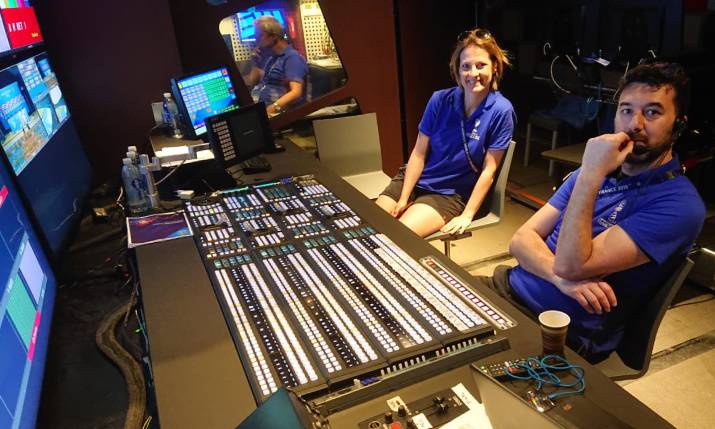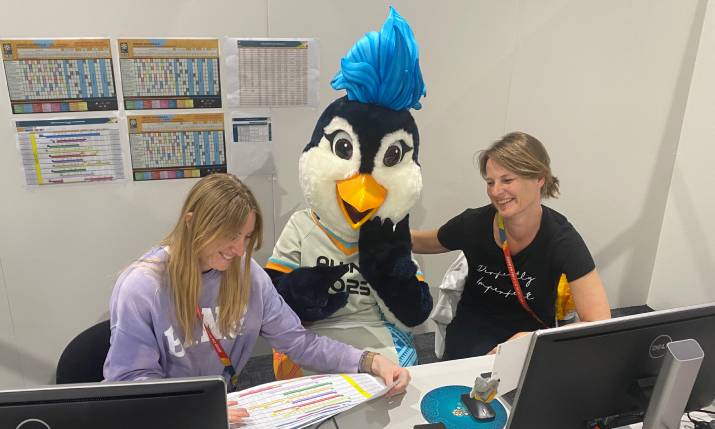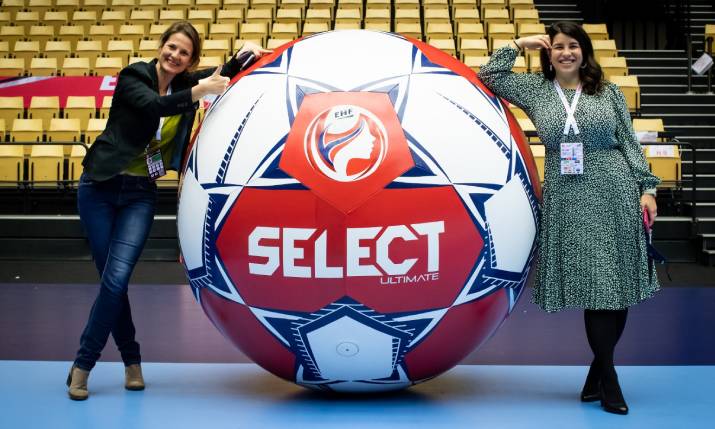Changing times: Considering technology and evolving views on gender in sports broadcasting with head of venue management at HBS Birgit Schiller

Birgit Schiller on site for the FIFA Women’s World Cup 2019 with colleague Riki Van Steeden, HBS senior producer live
Sports broadcasting is still a male dominated industry, but times are changing according to Birgit Schiller, head of venue management at HBS, who is also responsible for overseeing various events as a project director. Here we look at Schiller’s career path and how she sees this industry evolving.
The technologies used in sports broadcasting have evolved rapidly over recent years. What for you in your day to day job is the most exciting, and also what is the biggest gamechanger for this industry overall?
I think that the possibility of remote and cloud-based production changed and will change the industry the most. With more opportunities available the future of live sports broadcasting will be determined by the scale of an event, importance and budget.
From a venue management perspective, the event itself will of course continue to take place in an arena, a stadium, on a slope, etc, but we will also feel the changes. The industry is looking for ways to be more sustainable and reduce the carbon footprint. Therefore, solutions to reduce travel and shipping as well as more compact and multifunctional equipment will become important. There will be fewer people on site, as we have already seen with the FIFA Women’s World Cup 2023 where we had a completely remote production, which leads to a different dynamic at the venue. And broadcasters are also increasingly reducing their on-site operations and the services offered to them must be geared towards this.
What challenges have you faced over the course of your career?
When I started in the sports broadcast industry over 25 years ago, it was a very male-dominated area, and it still is. I always had the feeling that there were reservation and prejudices against women. In the editorial sector it always felt that we had to give more than 100% and any mistake seemed to be a bigger deal.
My female colleagues and I were sometimes confronted with behaviour that would cost many men their jobs today, but back then we were simply too young and inexperienced to position ourselves properly; but overall I felt respected.
I found it rather disappointing that back then there were certain professions, for example that of sports director, which simply felt unattainable, and indeed were. That has changed.
And even if I am not a fan of the women’s quota, it is changing perceptions and that is what is needed for women to be treated equally in the end.

At the FIFA Women’s World Cup Australia & New Zealand 2023, Birgit Schiller [right] with Charlotte Vidal [left], HBS production manager and project coordinator for the event, and the World Cup mascot, Tazuni [centre]
It depends on the area, but I find it challenging to keep up with the rapidly changing technologies and to live up to our ecological responsibility.
What also seems to be getting more and more difficult is recruiting the next generation. Sports production requires working hours that are far from the norm, long days, working weekends and often for long periods of time and it seems that the younger generation is less and less willing to put up with this.
What advice would you give to other women looking to move into a role in sports broadcasting like your own?
It is probably helpful if you know which area you are interested in – production, technical or editorial work – or at least what you would like to start with. So, get informed; the possibilities are manifold.
Nowadays it is easier to build a network, so take advantage of this opportunity and don’t be shy to ask people for advice and proactively for feedback.
But most important, do things you enjoy, be open and interested and stay true to yourself, and then things will fall into place all by themselves. At least that’s how it was for me.
How did you first find out about TV broadcasting as a career? What was your inspiration or idea, and why sports broadcasting?
I never thought about a career in the broadcasting industry. My first point of contact was more of a coincidence. I was studying media and communication at the German Sport University and needed an internship in audiovisual media. When I got in touch with the broadcaster of the German Bundesliga at the time, I entered an OB van for the first time and knew that this was where I wanted to work. Sport was always my passion, so I found the perfect combination.

Birgit Schiller [left] at the Women’s EHF Euro 2020 in Denmark alongside Jelena Bagaric, EHF TV and media operations plus media and communication manager
I studied Sport Science with a specialisation in media and communication. I thought I would rather end up working for written press, but that was just because I had no idea what range of jobs the broadcast industry offers.
Instead of an internship I started directly working as a freelancer for the broadcaster of the German football league – Premiere, which is now Sky Deutschland. I was responsible for editing the music closer of the top match. To be honest, I had no clue what I was doing, but thanks to the ENG camera ops, cutters, and technical personnel on the OB I had to work with, I learned a lot in a short period of time.
What other jobs and events have you worked on that moved you along in your sports broadcasting career?
I was a highlight producer followed the role of music closer producer. For four years, alongside my studies I worked for Premiere as a highlight producer for matches of the Bundesliga, the German Ice Hockey League (DEL) and competitions of the Olympic Games 2002. Furthermore, I worked as a video journalist for a small production company producing highlights and short form content on events like the IIHF World Championships 2001 and 2002, and Tour de France 2002.
In 2000 I joined the sports department of RTL Deutschland and continued to grow into various producer roles: from editorial assistant to story producer to live producer, and finally planning and implementation of outside broadcasts for the RTL programme. UEFA Champions League, DSV Ski Jumping, FIA Formula 1, various Boxing events and the IHF World Championships 2009 were the main sporting events I have worked on in 16 years at RTL.
Other employers were UEFA, Red Bull Mediahouse and Servus TV where I worked as a live producer for various events.
I have always found events that run over a longer period of time appealing, and the complexity of them fascinating. In 2013 I worked for HBS for the first time and that possibility gave my career a new boost. After being involved in further events, HBS hired me as a production manager for the FIFA World Cup 2018 project at the end of 2016. Afterwards I stayed to work in the venue management department for the FIFA Women’s World Cup 2019.
The range of my previous activities obviously contributed to the fact that HBS saw me in the role of project manager and gave me responsibility for setting up the host broadcast concept for Euros and Club Competitions for Infront client, the European Handball Federation (EHF).
We now only do the EHF Euros but together with our small team I think we have managed to set a new broadcast standard in recent years.
In 2022 I joined again the “big team” working on the FIFA projects and became the project manager for the FIFA Women’s World Cup 2023.
How did you get your current job role?
HBS advertised the role head of venue management internally in summer 2023 and I applied. The Women’s World Cup project was coming to an end and I didn’t have a new project yet, so I started thinking about this new challenge. Venues have always interested me since I first started working as a broadcast venue manager in 2015.
The job has only started, so it’s too early to reflect on it. It is definitely a challenge, but I love challenges. I like interacting at corporate and project level and to define and implement a new strategy together with the team to cater for the multi-project needs.

